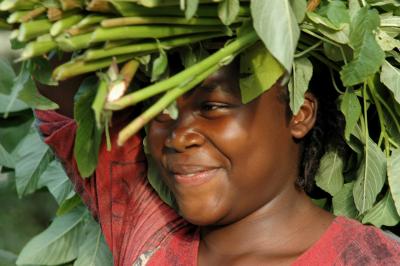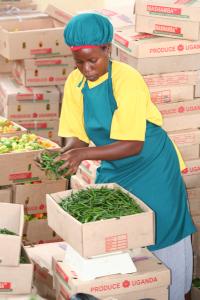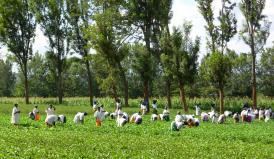
Agricultural producers in the African Caribbean and Pacific region, with the help of a European Commission backed project, are learning how to meet stringent regulations and requirements and continue to sell their foodstuffs in European markets.
For the producers, which include small-scale farmers, access to the lucrative European market is vital. But without support, they lacked the necessary training and infrastructure to meet strict EC legislation on food safety.
And this is where PIP, a European Union funded programme has successfully stepped in.
“Our focus has been to help existing enterprises revise their practices and implement food safety and traceability systems,” explained Guy Stinglhamber, Project Manager at PIP. “With support, many low-income producers were able to continue to export their goods to the European Union, and maintain a valuable source of income.”
PIP was established in 2001 initially to address new pesticide maximum residue limits. But this role soon expanded to provide a broad range of support to help ACP producers comply with a series of new EC regulations and market requirements concerning food safety.
During the 1990s, Europe experienced a series of food safety scares; incidents such as mad cow disease and fears over salmonella had the effect of denting consumer confidence, leading them to question the effectiveness of food safety control systems.
This prompted the European Commission to launch a process of regulatory reform based on a new approach to food safety, which required suppliers not only to produce safe food, but to apply and provide a paper trail, proving good practice “from field to fork”.
From 2000 onwards, several new items of EC legislation were introduced including the Maximum Residue Level harmonisation programme, setting new limits for pesticide residues in foodstuffs.
Over the next decade the EU regulatory reform was accompanied by a dramatic growth in the use of industry codes of practice or “private standards”. These were often more complex and stringent than the regulations and, though not a legal requirement, became obligatory for many companies wishing to access the high-value end of the EU retail market.
In the face of these new challenges, producers and exporters in the ACP countries risked being at a disadvantage. To ensure that they complied with the new requirements, they needed to rapidly acquire new knowledge and skills, and to adapt their production and management systems.
However, many lacked the necessary information, infrastructure, resources, and access to service providers. Small and medium sized enterprises and value chains involving large numbers of small-scale growers were particularly affected.

PIP: Supporting the ACP Horticultural Export Sector
PIP is a technical assistance programme financed by the European Union within the framework of support for private sector development. It is managed by the Europe African Caribbean Pacific Liaison Committee, or COLEACP - an association of EU importers and ACP producers and exporters of horticultural produce.
During the latter part of the 1990’s, COLEACP lobbied policy-makers and worked with the ACP Secretariat and the EC to put together the PIP programme. The initial objective was to ensure that ACP suppliers (and in particular smallholder growers) could comply with the new food safety regulations and thus maintain their share of the EU market.
Over time the scope of PIP evolved to address new challenges faced by ACP suppliers, in particular the growing demands for certification with private standards. Phase 1 of PIP ran from 2001-2009 and operated in 28 ACP countries, with a total budget of 38.2 million Euros.
PIP as a Technical Assistance Success Story
The core activities of PIP Phase 1 were focused on support to ACP producers and exporters. To ensure that food supplied to the EU was safe, traceable, and compliant with EU MRLs, PIP adopted the “field to fork” philosophy of the new EU regulatory framework.
An approach was developed to manage risk and promote good practice along the supply chain from field to point of shipment. This meant helping exporters install and maintain durable risk managements systems for food safety, traceability, in-house training, and integrated pest management (IPM).
To provide the necessary technical background, PIP developed crop protocols and guides for the 30 main ACP horticultural crops. These good practice guides provide itineraries which, if followed, ensure that produce complies with EU requirements.

Standardised training modules were also developed for the different players from company managers to food safety managers, field and packhouse workers, outgrower managers, and smallholders.
Success criteria
The first phase of PIP had a wide impact: beneficiary export companies together supplied over 80% of the volume of ACP fresh fruit and vegetables coming into the EU.
A number of key factors contributed to PIP’s success as a cooperation programme:
• Technical support was targeted in a way that ensured impact and sustainability (see itallic text below).
• PIP 1 worked in 28 countries under diverse conditions. To make best use of resources, support was delivered by developing generic tools to address common problems backed-up by specific actions to meet the needs of individual beneficiaries.
• Support to companies was accompanied by the capacity building of local service providers, thus ensuring that the ACP export sector has access to competent and affordable services over the long-term.
• PIP was managed through a grant contract with ex-post financial and technical control by the EC, a funding mechanism that awarded considerable decision-making responsibility to PIP, and giving the flexibility to evolve and respond to changing needs.
• The relatively long duration allowed the pace of support to be customised according to the response capacity of individual beneficiaries; SMEs with limited resources need time.

PIP Phase 2
By the end of PIP 1 horticultural exporters were facing new challenges: EU consumers are increasingly concerned about the social and environmental impact of the food they buy, and retailers are responding by imposing new schemes and standards on their suppliers.
In recognition of this, a second 5-year phase of PIP was launched in 2009 to address these new themes, as well as the still-evolving food safety agenda.
The overall goal of PIP Phase 2 is to maintain and, if possible, increase the contribution made by export horticulture to the reduction of poverty in ACP countries.
xxxxxxxxxxxxxxxxxxxxxxxxxxxxxxxxxxxxxxxxxxxxxxxxxxxxxxxxxxxxxxxxxxxxxxxxxxxxxxxxxx
Targeted support to ACP producers and exporters:
- PIP opted for a top-down approach. Compliance is expensive and for long-term sustainability must be resourced through the supply chain. For this reason, the main entry point for PIP was through exporters (SMEs) rather than producer groups or PMOs; exporters are in a better position to finance and sustain compliance and have the greatest vested interest.
- By working through exporters, PIP reached all the players in the supply-chain: smallholder outgrowers, farm workers, drivers, packhouse workers, etc.
- Support was provided from the very small to the very large exporters but, in the case of the latter, was confined to actions that enabled and encouraged these companies to continue to source from smallholder outgrowers.
- PIP worked with suppliers that had existing links with export markets. This met the PIP remit of protecting and maintaining existing export flows, and focused the use of limited resources where greatest impact was likely to be achieved.
- To ensure involvement and commitment, PIP used a participatory approach and based support on cost-sharing principles; success ultimately depended on money, time and resources being invested by the beneficiary.
- Support was not limited to one-off training, but delivered by a combination of collective training and customised support over time (1-5 years) that aimed for sustainability through a change in behaviour, mindset, and company restructuring


Log in with your EU Login account to post or comment on the platform.